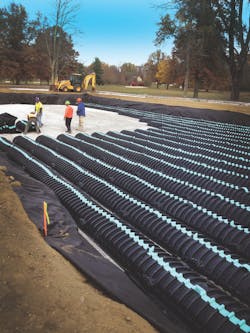About the author: Gina Carolan is COO and director of marketing for Cultec Inc. USA. Carolan can be reached at [email protected] or 203.775.4416.
The East of Hudson Watershed Corp. (EOHWC) is a not-for-profit development corporation established by the municipalities in northern Westchester, Putnam and Dutchess counties in the New York City Watershed to install storm water retrofit projects to meet the requirements for phosphorus reduction defined by the New York State Department of Environmental Conservation (NYSDEC).
According to the U.S. Environmental Protection Agency (EPA), 9 million residents of New York City and surrounding suburbs rely on a series of reservoirs located many miles away in watersheds in upstate New York for their drinking water supply. New York City uses approximately 1.5 billion gal per day of water, so building a water filtration plant to accommodate that capacity would be costly. In lieu of a plant, the city developed a Comprehensive Watershed Protection Plan in compliance with EPA’s Filtration Avoidance Determination (FAD), which details numerous measures the city would need to implement to protect its watershed. Both the FAD and Comprehensive Watershed Protection Plan are updated and revised periodically. The most recent update in July 2007 requires, among other actions, that the city address existing storm water runoff issues—including phosphorus removal—through the construction of storm water best management practices in accordance with Chapter 10 of the NYSDEC Stormwater Management Design Manual.
Pollutant Removal Solution
In order to reduce phosphorus in East of Hudson Watershed drinking water before the water reaches New York City, engineers from Weston & Sampson (W&S) designed, and construction contractors Ben Ciccone Inc. built and installed a storm water management system at the Putnam County Golf Course in Mahopac, N.Y. The original project concept was to include all porous pavement to allow direct infiltration for the golf course’s entire parking lot footprint, as well as storage in the gravel sub-base. For technical and regulatory reasons specific to the site, including significant grade, this idea was abandoned, and W&S and the EOHWC chose instead to install a subsurface infiltration system below a combination of pervious and conventional impervious asphalt pavement.
During storms, rainwater flows across impervious surfaces on roads, sidewalks, parking lots and other heavily trafficked surfaces, mobilizing contaminants. Over the years, a high level of phosphorus, found in the sediment mobilized during storms, contaminated the drinking water supply in northern Westchester, Putnam and Dutchess counties, causing algae growth in the reservoirs that affected the taste, color and odor of the water in New York City.
“Prior to this retrofit project, runoff would flow downstream to existing drainage swales without any real method of storm water management,” said Joe Zongol, P.E., engineer for W&S. “We worked with Cultec’s design reviewers on the calculations, and within a day or two had confirmed that our design would effectively accomplish the goal of significantly reducing the phosphorus levels in the water.”
Chamber Installation
Given the requirements of the site, W&S engineers decided that Cultec Inc.’s Contactor 100HD low-profile subsurface storm water management chamber would provide maximum storage and best satisfy the needs and restrictions of the site. A single chamber has a capacity of more than 100 gal, and measures 36 in. wide by 12.5 in. high. Each has an installed length of 7.5 ft with a bare chamber capacity of 1.85 cu ft per ln ft.
“One of our challenges was choosing a chamber that would allow us to meet the NYSDEC groundwater separation requirement,” said Carl Stone, P.E., team leader for W&S. “We had to slightly raise a portion of the parking lot grade to remain above the groundwater table, and the Contactor 100HD provided infiltration with a very low profile, so we didn’t have to raise the grade too high.”
The Contactor 100HD is ideal for sites with depth constraints or when a larger infiltrative area is required.
Contractors from Ben Ciccone Inc. installed the subsurface system, which included a total of 240 chambers arranged in 16 rows. Additionally, Cultec’s No. 410 filter fabric envelops the entire bed to prevent soil intrusion into the chamber bed.
“We have worked with Cultec’s products before, but this was the first time that I was directly involved with putting the chambers together, and they couldn’t have been easier to install,” said Mark Messina, project superintendent for Ben Ciccone Inc. “Our entire experience—from working with Cultec’s representatives for pointers to digging the hole, backfilling it with stone and snapping the chamber pieces together—was very positive and we look forward to working with Cultec again.”
The chambers are located beneath the section of the golf course’s parking lot that is constructed of permeable pavers that allow runoff to infiltrate directly into the system. Runoff from the asphalt portion of the parking lot is conveyed through conventional storm water collection structures and pipe into the infiltration system. In addition, a hydrodynamic separator helps remove grit and heavy sediment before water enters the chambers to minimize clogging of the gravel and permeable surface below the units. Incoming water creates a vortex or whirlpool within the conical separator, which promotes the settling of grit into a holding chamber below while grit-free storm water flows over a high-level weir into the chambers. The storm water is stored there until it can infiltrate into the ground.
“This storm water management project effectively addresses New York City’s need to protect its watershed,” Zongol said. “This is one of approximately 250 retrofit projects that will help continue to protect the drinking water supply from the harmful effects of excess phosphorus and other potential contaminants.”
Download: Here
